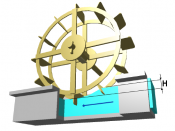History of the Water Wheel
From the olden times, a water wheel is a machine that uses flowing or falling water to produce power. It consists of a large wooden or metal wheel, with a number of blades or buckets arranged on the outside rim forming the driving surface. Most commonly, the wheel is mounted vertically on a horizontal axle, but the tub or Norse wheel is mounted horizontally on a vertical shaft. Vertical wheels can transmit power either through the axle or via a ring gear and typically drive belts or gears; horizontal wheels usually directly drive their load.
The waterwheel is an ancient device that uses flowing or falling water to create power by means of a set of paddles mounted around a wheel. The force of the water moves the paddles, and the consequent rotation of the wheel is transmitted to the machinery via the shaft of the wheel.
Water Wheels were used for crop irrigation, grinding grains, supply drinking water to villages and later to drive sawmills, pumps, forge bellows, tilt-hammers, trip hammers, and to power textile mills. They were probably the first method of creating mechanical energy that replaced humans and animals. As early as the first century, the horizontal waterwheel, which is terribly inefficient in transferring the power of the current to the milling mechanism, was being replaced by waterwheels of the vertical design. The earliest known description of a vertical water wheel is found in the writings of a Roman engineer by the name of Vituvius who lived in the Augustan age around 11 B.C. However, water wheels remained few and far between and were rarely employed as the two great sources of power in that day and age were men and animals. However, in the 4th century A.D. the Romans used 16...


![English: Water wheel powering a small village mill at the Museum of Folk Architecture and Life, Uzhhorod, Ukraine].](https://s.writework.com/uploads/16/161032/english-water-wheel-powering-small-village-mill-museum-folk-thumb.jpg)